英语现在完成时态讲解
(完整版)现在完成时态讲解

• 特殊: • am/is-was-been are-were-been, • do (does)-did-done go-went-gone • see-saw-seen • show-showed-shown (showed)
③ She has gone home. 她回家去了。
注意:1)该句式中的have或has是助动词,has用于第三人称单数,其它人称 一律用have。
2)该句式中have(has)和过去分词之间可用just插入。 3)把该句式译成汉语时,往往用“已经”,“刚刚”,“过”或“了”等.
2.现在完成时一般疑问句式是把助动词have或has提到主语之前。 如: ④ Have you read this story book yet? 你读过这本故事书吗? ⑤ Has he eaten that apple yet? 他吃那个苹果了吗?
动词的过去分词的规则变化
动词的过去分词的规则变化,在动词后加ed,规则变化有以下四种: ①原形+ed 如:worked, passed ②词尾是e时,直接加d 如:liked lived ③若词尾为“辅音字母加y”,则改y为i加ed;词尾 为“元音字母+y”时, 直接加d。如: played stayed studied cried ④末尾只有一个辅音字母的重读闭音节是,双写最后一个辅音字母加ed. 如: stopped dropped
• put-put-put
cut-cut-cut
• let-let-let
set-set-set
• beat-beat-beat
hit-hit-hit
• hurt-hurt-hurt
spit-spit-spit
• rid-rid-rid
英语现在完成时态讲解

英语现在完成时态讲解现在完成时一、定义:表示一个动作在过去发生并对现在产生影响表示一个动作由过去发生持续到现在有可能停下,也有可能延续下去表示一个动作从过去开始发生到目前为止已经发生多次。
二、构成:现在完成时是由“助动词have / has + 动词的过去分词”构成的,其规则动词的过去分词构成与过去式相同,不规则动词的过去分词则需加强记忆。
如:I have just cleaned my clothes.我刚洗过衣服。
My brother has done his homework already. 我的弟弟已经做完他的作业了。
友情提示:在现在完成时的各种结构中,have, has均为助动词,无实际意义,只起构成时态的作用,不可省略。
当主语是第三人称单数时助动词用has,其余人称一律用have。
过去分词1 、规则动词:规则动词的过去分词的构成规则与规则动词的过去式的构成规则相同。
四点变化规则:(1)、一般动词,在词尾直接加“ ed ”。
work---worked---worked ,visit---visited---visited(2)、以“ e ”结尾的动词,只在词尾加“ d ”。
live---lived---lived ,(3)、以“辅音字母+ y ”结尾的动词,将"y" 变为"i" ,再加“ ed ”。
study---studied---studied ,cry---cried---cried ,play---played---played ,stay---stayed---stayed(4)、重读闭音节结尾,末尾只有一个辅音字母,先双写该辅音字母,再加“ed ”。
stop---stopped---stopped ,drop---dropped--dropped2 、不规则动词:AAA型原型过去式过去分词burst burst burst cast cast castcost cost costcut cut cut hit hit hit hurt hurt hurtput put put set set set shut shut shutspread spread spread let let letAAB型beat beat beatenABA型become became become run ran run come came come特殊情况read read readread原形发音为/ri:d/,过去式和过去分词发音为/red/ABB型bring brought brought buy bought bought build built builtburn burnt burnt catch caught caught dig dug dugfeel felt felt fight fought foughtfind found foundlay laid laid lead led led lose lost lostmake made made meet met met sell sold soldABC型begin began begun blow blew blown break broke brokenchoose chose chosen draw drew drawn drive drove drivendrink drank drunk fly flew flown forgive forgave forgiven三、现在完成时的时间副词①用副词already和yet。
现在完成时讲解(完整版)(共17张PPT)
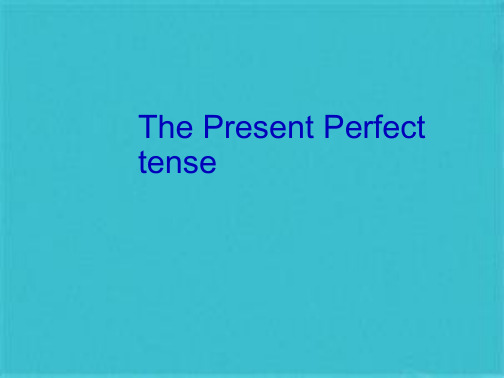
4. My friends haven’t visited me ___s_in_c_efew days ago.
5. We haven’t used our car _____faorlong time .
I have planted all the trees. 注:主语假设是第三人称单数助动词用 has
finished 9. goes 10. have, found 11. is He’ll be back soon.
Where’s Li Ming ? He __________ (go) to the teacher’s office.
否认形式 haven’t ( have not 〕 +过去分词 I ________ (see) it last week.
Where’s Li Ming ? He __________ (go) to the teacher’s office.
hasn’t ( has not ) +过去分词 have, stayed 8.
have, finished
have, stayed
• 1. have, seen, saw 2. Has, finished 3. has, —Yes, I ___________ New York twice.
You have planted all the trees. since: (自…以来)
6. She hasn’t had a good cup of coffee _____yefaorrs.
7. Tom has worn glasses _______he was 7 years old. since
英语语法-现在完成时讲解
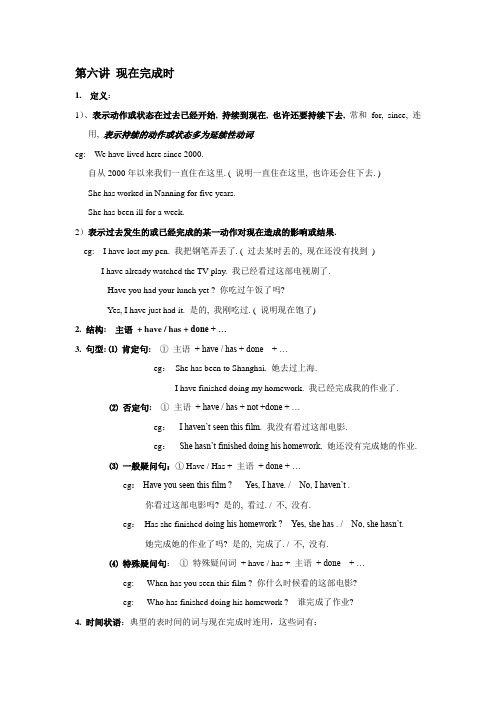
第六讲现在完成时1.定义:1)、表示动作或状态在过去已经开始, 持续到现在, 也许还要持续下去,常和for, since, 连用, 表示持续的动作或状态多为延续性动词.eg: We have lived here since 2000.自从2000年以来我们一直住在这里. ( 说明一直住在这里, 也许还会住下去. )She has worked in Nanning for five years.She has been ill for a week.2)表示过去发生的或已经完成的某一动作对现在造成的影响或结果.eg: I have lost my pen. 我把钢笔弄丢了. ( 过去某时丢的, 现在还没有找到)I have already watched the TV play. 我已经看过这部电视剧了.--- Have you had your lunch yet ? 你吃过午饭了吗?--- Yes, I have just had it. 是的, 我刚吃过. ( 说明现在饱了)2. 结构: 主语+ have / has + done + …3. 句型: ⑴肯定句: ①主语+ have / has + done + …eg:She has been to Shanghai. 她去过上海.I have finished doing my homework. 我已经完成我的作业了.⑵否定句: ①主语+ have / has + not +done + …eg:I haven’t seen this film. 我没有看过这部电影.eg:She hasn’t finished doing his homework. 她还没有完成她的作业.⑶一般疑问句:① Have / Has + 主语+ done + …eg: Have you seen this film ? Yes, I have. / No, I haven’t .你看过这部电影吗? 是的, 看过. / 不, 没有.eg:Has she finished do ing his homework ? Yes, she has . / No, she hasn’t.她完成她的作业了吗? 是的, 完成了. / 不, 没有.⑷特殊疑问句:①特殊疑问词+ have / has + 主语+ done + …eg: When has you seen this film ? 你什么时候看的这部电影?eg: Who has finished doing his homework ? 谁完成了作业?4. 时间状语:典型的表时间的词与现在完成时连用,这些词有:for 、since、already、yet、ever、never、recently、just、before、so far、by now、once ,twice…等连用.注意: for+一段时间since+过去的某一个时间点I have lived in Nanning for ten years.I have lived in Nanning since ten years ago/ 2002.I haven’t seen him for 15 years .I have never seen him since 1998.already :用于肯定句, 可放在助动词之后、过去分词之前,也可放在句末.I have already finished my homework.yet: 用在疑问句中意为”已经”, 用在否定句中表示”还”, 常放在句末.Have you finished your homework yet?I haven’t finished my homework yet.ever: 曾经用于疑问句中:Have you ever been to Beijing?Have you ever been to Shanghai ? 你去过上海吗?never: 未曾从未I have never traveled by plane before. 我以前从来没有乘飞机旅行过.recently:最近用于肯定否定疑问句中I have been busy recently.We have not seen Tom recently.Have they been here recently.eg: I have just seen Tom.I haven’t heard of it before. 我以前从来没有听说过这件事.They have planted 2000 trees so far.The child has learned 100 English words by now.5. 当与一段时间连用时, 经常用for 加一段时间, 这时候谓语动词一定要用延续性的.非延续性动词----延续性动词改错:They have got married for ten years. I have borrowed this book for a week.get married--- be married borrow --- keepcome ---- be here go --- be away / off buy --- havestart / begin --- be on leave --- be away die --- be deadarrive---be in/at join---be in /be a member of stop---be overreturn----be back open/close---be closed/openeg: He came here three days ago. 他三天前来的这. (一般过去时)He has been here for three days. 他来这已经三天了.(现在完成时与一段时间连用, 非延续性动词变延续性动词. )He went to Dalian last week. 他上周去的大连. ( 一般过去时)He has been away for a week. 他已经离开有一周了. ( 现在完成时)I bought the book last month. 我去年买的这本书. ( 一般过去时)I have had the book for a month. 我保管这本书有一周了. ( 现在完成时)The football match started an hour ago.The football match has been on for an hour.7. 现在完成时与一般过去时的区别:1)、侧重点不用,现在完成时是与现在有关的时态,侧重于过去的动作对现在造成影响,而一般过去时是一种过去的时态,侧重于表示过去的动作,与现在无关。
现在完成时讲解

现在完成时讲解LEKIBM standardization office【IBM5AB- LEKIBMK08- LEKIBM2C】现在完成时讲解一.基本结构:助动词have/has+过去分词(done)二.句型:否定句:主语+have/has+not+过去分词+其他. 一般疑问句:Have/Has+主语+过去分词+其他. 简略答语: Yes, 主语 + have/has.(肯定) No, 主语 + haven't/hasn't.(否定)三.用法(1)现在完成时表示过去发生或已经完成的动作对现在造成的影响或结果I have spent all of my money (so far).(含义是:现在我没有钱花了.)Guo zijun has (just/already) come. (含义:郭子君现在在这儿)My father has gone to work.(含义是:我爸爸现在不在这儿)(2)现在完成时可以用来表示发生在过去某一时刻的,持续到现在的动作(用行为动词表示)或状态(be动词表示)常与for(+时间段),since(+时间点或过去时的句子)连用.①for+时段②since+过去一个时间点(译为:自从……以来)③since+时段+ago④since+从句(过去时)⑤It is+时段+since+从句(过去时)Mary has been ill for three days.I have lived here since 1998.四.has gone (to),has been (to), has been (in) 的区别Have/Has gone(to) :去了(现在不在说话现场)Where is your father?He has gone to Shanghai.Have/Has been (to) :去过(已不在去过的地方)My father has been to Shanghai.Have/has been in:呆了多久(还在所呆的地方)My father has been in Shanghai for two months. /since two months ago.五.现在完成时的标志1.现在完成时的含义之一是过去完成的动作对现在仍有影响,用以下四大标志词可以表达这种含义:* 以already, just和yet为标志He has already got her help.他已得到她的帮助。
现在完成时的概念与典型句型解析
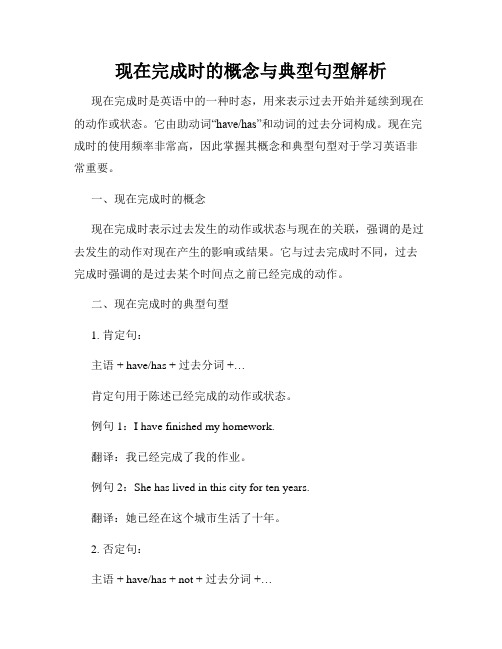
现在完成时的概念与典型句型解析现在完成时是英语中的一种时态,用来表示过去开始并延续到现在的动作或状态。
它由助动词“have/has”和动词的过去分词构成。
现在完成时的使用频率非常高,因此掌握其概念和典型句型对于学习英语非常重要。
一、现在完成时的概念现在完成时表示过去发生的动作或状态与现在的关联,强调的是过去发生的动作对现在产生的影响或结果。
它与过去完成时不同,过去完成时强调的是过去某个时间点之前已经完成的动作。
二、现在完成时的典型句型1. 肯定句:主语 + have/has + 过去分词+…肯定句用于陈述已经完成的动作或状态。
例句1:I have finished my homework.翻译:我已经完成了我的作业。
例句2:She has lived in this city for ten years.翻译:她已经在这个城市生活了十年。
2. 否定句:主语 + have/has + not + 过去分词+…否定句用于陈述尚未完成的动作或表达否定的状态。
例句1:I have not seen the movie yet.翻译:我还没有看过这部电影。
例句2:He has not finished his work.翻译:他还没有完成他的工作。
3. 疑问句:Have/Has + 主语 + 过去分词+… + ?疑问句用于询问是否已经完成或发生了某个动作或状态。
例句1:Have you ever been to London?翻译:你去过伦敦吗?例句2:Has she finished her presentation?翻译:她完成了她的演讲吗?4. 现在完成时与时间状语连用:现在完成时经常与时间状语连用,用于强调动作或状态的持续时间。
表示延续时间的时间状语:for + 时间段表示起始时间的时间状语:since + 完整时间点例句1:I have lived in this house for five years.翻译:我已经在这个房子里住了五年了。
现在完成时语法解释大全
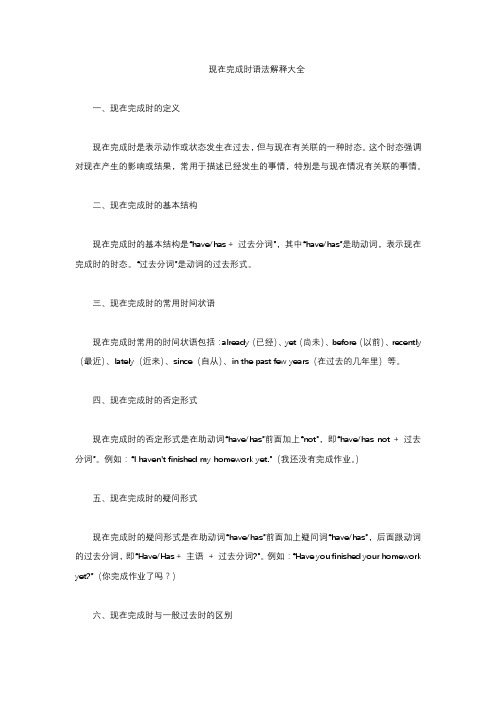
现在完成时语法解释大全一、现在完成时的定义现在完成时是表示动作或状态发生在过去,但与现在有关联的一种时态。
这个时态强调对现在产生的影响或结果,常用于描述已经发生的事情,特别是与现在情况有关联的事情。
二、现在完成时的基本结构现在完成时的基本结构是“have/has + 过去分词”,其中“have/has”是助动词,表示现在完成时的时态。
“过去分词”是动词的过去形式。
三、现在完成时的常用时间状语现在完成时常用的时间状语包括:already(已经)、yet(尚未)、before(以前)、recently (最近)、lately(近来)、since(自从)、in the past few years(在过去的几年里)等。
四、现在完成时的否定形式现在完成时的否定形式是在助动词“have/has”前面加上“not”,即“have/has not + 过去分词”。
例如:“I haven't finished my homework yet.”(我还没有完成作业。
)五、现在完成时的疑问形式现在完成时的疑问形式是在助动词“ha ve/has”前面加上疑问词“have/has”,后面跟动词的过去分词,即“Have/Has + 主语+ 过去分词?”。
例如:“Have you finished your homework yet?”(你完成作业了吗?)六、现在完成时与一般过去时的区别现在完成时与一般过去时都表示过去发生的动作或状态,但它们的重点不同。
现在完成时强调对现在的影响或结果,而一般过去时只是简单地描述过去发生的事情,不涉及现在的状态。
例如:“I finished my homework an hour ago.”(我一小时前完成了作业。
)(用一般过去时)和“I have finished my homework now.”(我已经完成了作业。
)用现在完成时则强调现在不需要做作业了,对现在的情况产生了影响。
英语现在完成时态的技巧和方法

现在完成时态是英语语法中的一个重要时态,它表示某个动作或状态从过去一直持续到现在,并且有可能持续到未来。
要掌握现在完成时态,需要掌握以下技巧和方法:
1. 理解现在完成时态的含义:现在完成时态表示某个动作或状态从过去一直持续到现在,并且有可能持续到未来。
这个时态强调对现在的影响和结果。
2. 识别现在完成时态的标志词:现在完成时态的标志词包括“have/has + 过去分词”的组合,如“have/has been”、“have/has done”等。
同时,也要注意一些可以表示完成时态的副词,如“already”、“yet”、“still”等。
3. 注意现在完成时态的否定形式:现在完成时态的否定形式是在助动词“have/has”后面加上“not”,例如“haven’t/hasn’t + 过去分词”。
4. 理解现在完成时态与一般过去时态的区别:现在完成时态强调的是对现在的影响和结果,而一般过去时态只是简单地陈述过去发生的事情。
5. 注意与现在完成时态相关的时态搭配:现在完成时态可以与一些其他时态搭配使用,如过去进行时态、将来时态等。
这些时态搭配可以帮助表达更加丰富和复杂的语义。
6. 多练习现在完成时态的用法:要掌握现在完成时态,多练习是关键。
可以通过写作、口语、阅读和听力等练习来提高现在完成时态的运用能力。
总之,要掌握现在完成时态,需要理解其含义、标志词、否定形式以及与其它时态的区别,并多加练习。
同时,注意理解对现在的影响和结果,这是这个时态的核心要点。
现在完成时知识讲解

现在完成时知识讲解(总5页) -CAL-FENGHAI.-(YICAI)-Company One1-CAL-本页仅作为文档封面,使用请直接删除专项语法讲练——现在完成时【概念引入】如何学习时态对中学生来说,最好还是从各个时态的基本概念、基本形式和基本用法学起。
在过了这一阶段之后,再放开步伐,通过大量的听、读和笔头实践,获得感性的知识。
现在,我们就从最基本的概念、形式和用法等方面来总结一种新的时态——现在完成时。
【用法讲解】一、现在完成时的定义现在完成时表示过去发生或已经完成的某一动作对现在造成的影响或结果。
二、现在完成时的构成1. 肯定句现在完成时的肯定句式是“have(has)+过去分词”。
注意:该句式中的have或has是助动词,has用于第三人称单数,其它人称一律用have。
2. 否定句:现在完成时的否定句式是“haven’t(hasn’t)+过去分词”。
3. 疑问句:现在完成时的一般疑问句式是把助动词have或has提到主语之前。
回答用Yes, …have(has)./ No, …haven’t(hasn’t).三、动词过去分词规则变化与不规则变化(一) 规则变化变化规则:与动词过去式规则相同。
1. 一般直接在词尾加上ed。
look — looked2. 以e结尾的动词,直接加d。
move — moved3. 以y结尾,y前面是辅音字母的动词,变y 为i,再加ed。
carry — carried4. 部分动词需双写尾字母,加ed。
stop — stopped(二)不规则变化不规则动词的变化因词而异。
但是如果对不规则动词的过去式和过去分词做一分析,就可发现其中的“规则”。
同学们在记忆时,可按下面的形式对教材后不规则动词表进行分析、整理。
例如:AAB型AAA型ABA型ABB型四、现在完成时的用法现在完成时表示过去某时发生的行为对主语目前产生的影响。
即用过去发生的某个行为来说明现在的某种情况。
现在完成时讲解

现在完成时讲解一、现在完成时的构成(一)肯定式主语+助动词have /has +过去分词+其它说明:这里的have /has是助动词,没有什么具体意义。
当主语是第三人称单数时助动词用has,其余人称一律用have。
has,have的缩略式分别为’s或’ve。
规则动词过去分词的构成与过去式的构成方式一样,不规则动词可参看不规则动词表。
实例:1)I’ve just copied all the new words .我刚抄写了所有的生词。
(表示不要再抄了)2)She has lost her books .她丢失了她的书。
(表示到目前为止还没有找到)(如果用过去时:She lost her books . 则强调书是过去丢的这一动作,而不知现在有没有找到)3)We’ve just cleaned the classroom .我们刚好打扫了教室。
(表明现在教室是干净的)(二)否定式主语+助动词have /has+not+过去分词+其它说明:现在完成时构成否定句时,只需在助动词have /has后面加not就行。
have not,has not的缩略式分别为haven’t ,hasn’t。
另外,肯定句中有some,already时,改为否定时要分别改成any,yet。
实例:1)I haven’t finished my homework yet.我还没有完成我的作业。
2)She hasn’t travelled on a train .她没有坐火车旅行过。
3)We have never spoken to a foreigner.我们从来没有和外国人说过话。
注:有时not可以用never代替,表示“从来没有”的意思。
又如:4)I have never seen him before.以前我从来没有见过他。
(三)一般疑问式助动词Have /Has +主语+过去分词+其它?说明:把陈述句中的have或has放到句首,句末打问号,同时把句中的some ,already改为any ,ye t就构成了一般疑问句。
现在完成时的用法讲解

现在完成时的用法讲解一、现在完成时的基本概念和构成现在完成时是英语中一个常用的时态,用来表示过去发生或已经完成的动作与现在的关系。
它由助动词“have/has”和动词的过去分词构成,其中“have”用于第一人称和第二人称,而“has”则用于第三人称单数。
二、现在完成时的基本用法1. 表示过去开始并持续到现在的动作或状态:例如:I have worked in this company for five years.(我已经在这家公司工作五年了。
)2. 表示过去曾经做过的事情对当前造成影响或产生结果:例如:She has lost her keys, so she can't open the door.(她丢失了钥匙,所以无法打开门。
)3. 表示某个时间点之前已经发生或完成的动作:例如:I have already finished my homework.(我已经完成了我的家庭作业。
)三、与时间状语连用的特殊情况1. 使用含有未来概念的时间状语时,需使用将来完成时代替现在完成时:例如:By next week, I will have finished this project.(到下周,我将会完成这个项目。
)2. 使用指定时间点为止加上“for”或“since”的状语时:例如:I have been studying English for five years.(我已经学习英语五年了。
)例如:He has lived in London since 2010.(他自2010年以来一直住在伦敦。
)四、与其他时态的对比1. 与一般过去时对比:现在完成时强调动作带来的结果或影响,而一般过去时则着重指明具体发生的时间点。
2. 与过去完成时对比:现在完成时强调过去到现在产生的影响或结果,而过去完成时则强调过去某个时间点之前已经完成的动作。
3. 与将来完成时对比:将来完成时用于表示将来某个时间点之前已经发生或已经完成的事情,而现在完成时则用于表示从过去某个时间点开始到现在所持续的动作或状态。
初中英语 时态讲解:现在完成时

时态讲解:现在完成时1)现在完成时通常表示过去发生或已经完成的某一动作对现在造成的影响和结果。
说话人强调的是该动作或状态对现在的结果或影响。
My daughter has just gone out. 我女儿刚出去。
I’m sure we’ve met before. 我肯定我们以前见过面。
She has arrived. 她到了。
2)表示开始于过去并持续到现在的动作或状态,往往和包括现在在内的表示一段时间的状语连用,如recently, already, just, lately, for…, since…,yet等。
如:I haven’t heard from her these days. 这些日子我没有收到她的信。
We haven’t seen you recently. 最近我们没有见到你。
They have been away for two years. 他们离开已经两年了。
She has been with us since Monday.3). 现在完成时还可以用来表示过去的一个时间到现在这段时间内重复发生的动作.We have had four texts this semester.6. have been to 和have gone to的区别have been to 强调“去过”,现已不在那里,如:He has been to the USA three times.他到美国去过三次。
(过去“到美国”,现在已“不在美国”)have gone to主要强调的是“去了”,现在人不在说话的现场,如:--Where's your mother? --你妈妈在哪?--She has gone to the hospital. --她去医院了。
一结构1.肯定句:主语+have/has+动词的过去分词+其他2.否定句:主语+have/has+not+动词的过去分词+其他3.一般疑问句:have/has+主语+动词的过去分词+其他Yes, 主语+have/has. No , 主语+have/has+not4.特殊疑问句:特殊疑问词+have/has+主语+动词的过去分词+其他二常和现在完成时一起连用的时间状语注意:.现在完成时不能单独与准确时间连用,(如表示过去的时间状语)如yesterday(morning、afternoon),last(morning、afternoon)等,除非与for, since连用.1.现在完成时往往同表示不确定的过去时间状语连用如already(肯定), yet(否定,疑问), just, before, recently, still, lately,Just, already, yet, ever, never, before, twice(重复性时间),for+短时间,since+点时间,so far, how long 提问的疑问句中.......He has already obtained a scholarship.I haven't seen much of him recently (lately).We have seen that film before.Have they found the missing child yet ?2. 现在完成时常常与表示频度的时间状语连用,如ever, never, twice, several times等:Have you ever been to BeijingI have never heard Bunny say anything against her.I have used this pen only three times. It is still good.George has met that gentleman several times.3. 现在完成时还往往可以同包括现在时间在内的时间状语连用,如up to these few days/weeks/months/years, just, up to present(now), so far等:Peter has written six papers so far.Up to the present everything has been successful.三当现在完成时与表示短时间的时间状语连用时,谓语动词必须使用延续性动词。
英语现在完成时态知识点梳理归纳总结

英语现在完成时态知识点梳理归纳总结英语是一门广泛使用的语言,掌握好英语的时态是学习英语的关键之一。
其中,现在完成时态是英语中较为复杂和常用的一种时态,因此对其进行深入的了解和掌握是学习英语的基础。
本文将对英语现在完成时态的知识点进行梳理、归纳和总结。
一、现在完成时态的构成与用法1. 构成:现在完成时态由“have/has + 过去分词”构成。
其中,have用于第一人称和第二人称(I、you、we、they),has用于第三人称单数(he、she、it)。
2. 用法:(1)表示过去某个时间点开始,持续到现在仍在进行的动作或状态。
例如:I have lived in this city for 10 years.(我在这个城市住了10年了。
)(2)表示过去某个时间点发生的动作对现在产生的影响或结果。
例如:I have finished my homework, so I can go out to play.(我已经完成作业了,所以我可以出去玩。
)(3)用于经验、经历、成就等方面的表达。
例如:I have visited Paris twice.(我去过巴黎两次。
)3. 时间状语的使用:现在完成时态常与以下时间状语连用,如already(已经)、just (刚刚)、yet(还、已经)等。
例如:Have you finished your work yet?(你的工作做完了吗?)二、现在完成时态与其他时态的区别1. 现在完成时态与一般过去时:现在完成时态强调过去发生的动作与现在的联系,而一般过去时则仅仅表示过去发生的动作,没有现在的联系。
例如:They have cleaned the room.(他们已经打扫了房间。
)(现在完成时态)They cleaned the room yesterday.(他们昨天打扫了房间。
)(一般过去时)2. 现在完成时态与过去进行时:现在完成时态强调的是动作的完成,而过去进行时则强调的是动作的进行。
完整版)现在完成时的用法详解

完整版)现在完成时的用法详解现在完成时是英语中的一种时态,表示动作或状态已经发生,对现在产生影响或有关联。
下面是现在完成时的用法详解:一、构成和用法:现在完成时由助动词“have/has”加上动词的过去分词构成。
下面是不同人称的构成方式:I/we/you/they + have + 过去分词He/she/it + has + 过去分词现在完成时的用法包括以下几个方面:1.表示过去发生的动作对现在产生的影响或结果:I have ___(我已经完成作业了)2.表示过去开始的动作一直延续到现在并可能继续下去:She has lived in New York for five years.(她在纽约已经住了五年了)3.表示经历过的经历或动作:Have you ever been to Paris?(你去过巴黎吗?)4.表示已完成的动作或状态:They have already left.(他们已经走了)二、使用注意事项:使用现在完成时需要注意以下几点:1.不能和过去时间状语连用:He has already left yesterday.(错误)应改为He left yesterday.(正确)2.不能和表示过去具体的时间连用:I have seen her last night.(错误)应改为I saw her last night.(正确)3.可以和表明时间段的时间状语连用:I have lived here for three years.(我在这里住了三年了)4.可以和表示过去到现在一段时间的时间状语连用:I have known him since 2010.(从2010年起我就认识他)以上就是现在完成时的用法详解,希望对你有帮助。
初中英语语法现在完成时专题讲解
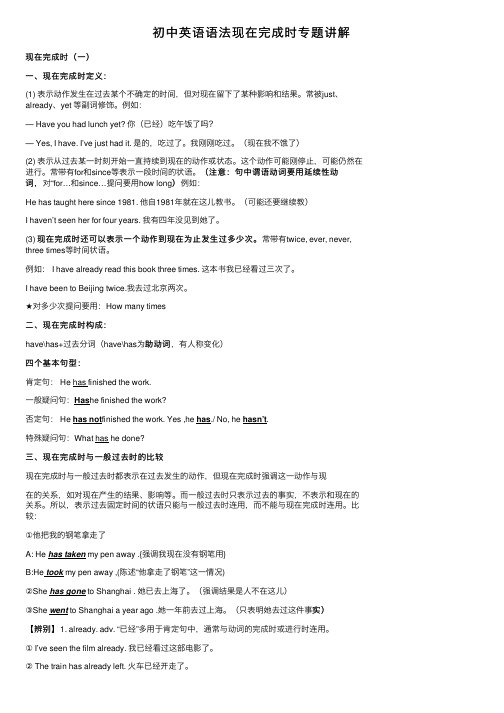
初中英语语法现在完成时专题讲解现在完成时(⼀)⼀、现在完成时定义:(1) 表⽰动作发⽣在过去某个不确定的时间,但对现在留下了某种影响和结果。
常被just、already、yet 等副词修饰。
例如:— Have you had lunch yet? 你(已经)吃午饭了吗?— Yes, I have. I’ve just had it. 是的,吃过了。
我刚刚吃过。
(现在我不饿了)(2) 表⽰从过去某⼀时刻开始⼀直持续到现在的动作或状态。
这个动作可能刚停⽌,可能仍然在(注意:句中谓语动词要⽤延续性动进⾏。
常带有for和since等表⽰⼀段时间的状语。
(注意:句中谓语动词要⽤延续性动词,对“for…和since…提问要⽤how long)例如:词,He has taught here since 1981. 他⾃1981年就在这⼉教书。
(可能还要继续教)I haven’t seen her for four years. 我有四年没见到她了。
现在完成时还可以表⽰⼀个动作到现在为⽌发⽣过多少次。
常带有twice, ever, never, (3) 现在完成时还可以表⽰⼀个动作到现在为⽌发⽣过多少次。
three times等时间状语。
例如: I have already read this book three times. 这本书我已经看过三次了。
I have been to Beijing twice.我去过北京两次。
★对多少次提问要⽤:How many times⼆、现在完成时构成:have\has+过去分词(have\has为助动词助动词,有⼈称变化)四个基本句型:肯定句: He has finished the work.⼀般疑问句:Has he finished the work?否定句: He has not finished the work. Yes ,he has./ No, he hasn’t.特殊疑问句:What has he done?三、现在完成时与⼀般过去时的⽐较现在完成时与⼀般过去时都表⽰在过去发⽣的动作,但现在完成时强调这⼀动作与现在的关系,如对现在产⽣的结果、影响等。
初中英语现在完成时详细讲解

初中英语语法现在完成时详细讲解现在完成时是英语中一种表示过去发生的动作对现在产生的影响或结果的时态。
它由"have/has + 过去分词"构成。
现在完成时的用法如下:
1. 表示过去发生的动作对现在产生的影响或结果:
①I have finished my homework.(我已经完成了我的作业。
)这里表示过去完成的动作是完成作业,现在的结果是作业已经完成。
②They have lived in this city for five years.(他们在这个城市已经生活了五年。
)这里表示过去完成的动作是生活在这个城市,现在的结果是他们已经在这个城市生活了五年。
2. 表示从过去某一时间点开始到现在一直持续的动作:
①She has worked at this company since 2010.(她从2010年起在这家公司工作。
)这里表示过去从2010年开始工作,到现在一直在这家公司工作。
3. 表示过去已经发生但时间未具体提及的动作:
①Have you ever been to Paris?(你去过巴黎吗?)这里表示过去是否有去过巴黎,但并未提及具体时间。
需要注意的是,现在完成时强调的是过去的动作与现在的关系,因此常用于包含现在的句子中。
同时,现在完成时通常与表示一段时间的时间状语连用,如for、since等,以强调动作的持续性或延续性。
另外,现在完成时不能与明确的过去时间状语连用,如yesterday、last week等,因为这些表示过去具体时间点的状语与现在完成时的
概念不符。
在这种情况下,应使用过去时态表示过去发生的动作。
英语现在完成时时态语法知识讲解

英语现在完成时时态语法知识讲解现在完成时表示过去发生的动作对现在造成的影响或结果或表示过去的动作或状态持续到现在。
下面小编给大家分享了有关现在完成时的英语语法知识,一起来看看吧!现在完成时的基本结构和句型一.基本结构:助动词have/has+过去分词(done)二.句型:否定句:主语+have/has+not+过去分词+其他.一般疑问句:Have/Has+主语+过去分词+其他.简略答语: Yes, 主语 + have/has.(肯定)No, 主语 + haven't/hasn't.(否定)现在完成时的用法详解一、现在完成时句型构成基本结构:主语+have/has+动词的过去分词(p.p)(V-ed) e.g done二、现在完成时用法①肯定句中:主语+has/have+动词的过去分词(p.p)(V-ed)+宾语(或者其他).②否定句中:主语+haven't/hasn't+动词的过去分词(p.p)(V-ed)+宾语.③一般疑问句中:Have/Has+主语+动词的过去分词(p.p)(V-ed)+宾语(或者其他).(末尾用问号)三、现在完成时用法要点1.现在完成时不能单独与准确时间连用,(如表示过去的时间状语)如yesterday(morning、afternoon),last(morning、afternoon)等,除非与for,since连用.2.现在完成时往往同表示不确定的过去时间状语连用如already(肯定,句中),yet(否定,疑问,句中),just,before,recently,still,lately,never等:He has already obtained a scholarship.他已经获得了一份奖学金。
I haven't seen much of him recently (lately).我已经很久没有看到他(最近的)。
We have seen that film before.我们以前已经看过那部电影了。
初中英语现在完成时态详细讲解及其练习

注意事项
单击此处可添加副标题
have been(to)与 have gone( to)的区别:have been(to)表示“去过某地(现在已经回来了)”,可用于 各人称;have gone(to)表示“去某地了(说话时某人不 在当地)”,常用于第三人称,前者可与 once , never, several times 等连用,后者则不能。
pictures ❖ (A ) has just (B)have ever (C)has yet
(D)have already
❖ 二 选择填空
_ ❖ ( ) 1. ——Have you finished your homework ——Yes, I it last night ❖ (A) finish (B) finished (C) have finished (D) will finish
三 用 since 和 for 填空 (一)
❖ 1) ______ two years _______ two years ago 2) _______ last month 3) _______ yesterday 4) _______ an hour ago 5) ______ she left here 6) _______ 4 o’clock 8) ______ 1999
归纳总结:由非延续性动词到延续性动 词的转换
• arrive→be here die →be dead begin (start)→ be on • come back→ be back fall ill (sick, asleep )→be ill (sick,
asleep) leave →be away get up→ be up finish →be over • open →be open close →be closed borrow →keep • be on →be in 或 be a member of… go to school→be a
现在完成时知识点

现在完成时知识点现在完成时是英语中的一种时态,用来描述已经发生的动作或已经完成的状态。
在现在完成时中,动词的形式由“have/has + 过去分词”构成。
下面将介绍现在完成时的相关知识点。
一、现在完成时的构成现在完成时的肯定句结构为:“主语+ have/has + 过去分词”。
其中,当主语为第一人称单数(I)时,使用have;当主语为第三人称单数(he/she/it)或复数时,使用has。
过去分词的构成方式有规则变化和不规则变化。
1. 规则变化的过去分词规则变化的过去分词是指动词的过去式和过去分词形式相同,通常在动词原形后加-ed。
如:play-played, work-worked。
2. 不规则变化的过去分词不规则变化的过去分词是指动词的过去式和过去分词形式不同,需要通过记忆。
如:go-gone, eat-eaten。
二、现在完成时的用法现在完成时主要用来表示过去发生的动作对现在造成的影响或结果。
具体用法如下:1. 表示过去发生的动作对现在造成的影响例如:- I have lost my keys.(我丢了钥匙。
)- She has broken her leg.(她摔断了腿。
)2. 表示过去已完成的动作对现在造成的结果例如:- They have finished their homework.(他们已经完成了作业。
)- He has bought a new car.(他买了一辆新车。
)3. 表示过去开始的动作一直持续到现在例如:- I have known her for five years.(我认识她已经五年了。
)- He has worked in this company since 2010.(他从2010年开始在这家公司工作。
)4. 表示过去发生的动作在过去某个时间点之前已经完成例如:- I had read the book before the movie came out.(在电影上映之前,我已经读过这本书了。
中考英语-现在完成时态专题讲解
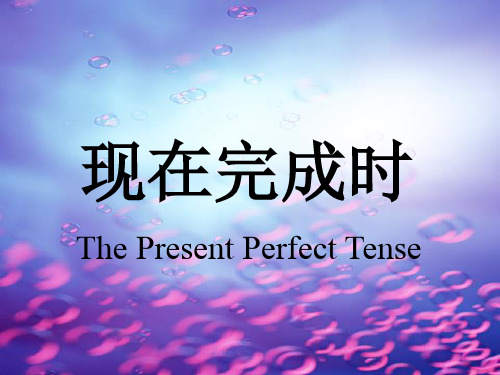
选用 for和 since填空:
1.We haven’t seen each other __f_o_r __ a long time.
2.His father has been in the Party __s_in_c_e_ 10 years ago.
3.The film has been on _f_o_r___ 20 minutes.
4.Mr Green has worked here __s_in__ce_ he came to China.
5.His grandparents have been dead _f_o_r___ several years.
1.Already
※用于肯定句: 句中(行动前,be动后)意为 “己经”。偶尔用于句尾表示强调,但很少
见Eg. I’ve already had breakfast. (更常见) = I’ve had breakfast already.(表示强调)
有时到
He likes playing soccer. He started playing soccer at 1:00 pm. He is still playing soccer now.
Start: 1:00pm Now:3:00pm
He has played soccer for two hours.
4.He has returned to Beijing. Has he returned to Beijing? Yes, he has . No ,he hasn’t
1.你洗脸了吗? Have you washed your face?
- 1、下载文档前请自行甄别文档内容的完整性,平台不提供额外的编辑、内容补充、找答案等附加服务。
- 2、"仅部分预览"的文档,不可在线预览部分如存在完整性等问题,可反馈申请退款(可完整预览的文档不适用该条件!)。
- 3、如文档侵犯您的权益,请联系客服反馈,我们会尽快为您处理(人工客服工作时间:9:00-18:30)。
现在完成时一、定义:表示一个动作在过去发生并对现在产生影响表示一个动作由过去发生持续到现在有可能停下,也有可能延续下去表示一个动作从过去开始发生到目前为止已经发生多次。
二、构成:现在完成时是由“助动词have / has + 动词的过去分词”构成的,其规则动词的过去分词构成与过去式相同,不规则动词的过去分词则需加强记忆。
如:I have just cleaned my clothes.我刚洗过衣服。
My brother has done his homework already. 我的弟弟已经做完他的作业了。
友情提示:在现在完成时的各种结构中,have, has均为助动词,无实际意义,只起构成时态的作用,不可省略。
当主语是第三人称单数时助动词用has,其余人称一律用have。
过去分词1 、规则动词:规则动词的过去分词的构成规则与规则动词的过去式的构成规则相同。
四点变化规则:(1)、一般动词,在词尾直接加“ ed ”。
work---worked---worked ,visit---visited---visited(2)、以“ e ”结尾的动词,只在词尾加“ d ”。
live---lived---lived ,(3)、以“辅音字母+ y ”结尾的动词,将"y" 变为"i" ,再加“ ed ”。
study---studied---studied ,cry---cried---cried ,play---played---played ,stay---stayed---stayed(4)、重读闭音节结尾,末尾只有一个辅音字母,先双写该辅音字母,再加“ ed ”。
stop---stopped---stopped , drop---dropped--dropped2 、不规则动词:AAA型原型过去式过去分词burst burst burst cast cast cast cost cost costcut cut cut hit hit hit hurt hurt hurtput put put set set set shut shut shutspread spread spread let let letAAB型beat beat beatenABA型become became become run ran run come came come特殊情况read read readread原形发音为/ri:d/,过去式和过去分词发音为/red/ABB型bring brought brought buy bought bought build built builtburn burnt burnt catch caught caught dig dug dugfeel felt felt fight fought foughtfind found foundlay laid laid lead led led lose lost lostmake made made meet met met sell sold soldABC型begin began begun blow blew blown break broke brokenchoose chose chosen draw drew drawn drive drove drivendrink drank drunk fly flew flown forgive forgave forgiven三、现在完成时的时间副词①用副词already和yet。
already一般用于肯定句中,yet一般用于否定句和疑问句中。
We have already finished our homework. 我们已完成作业了。
They haven't finished their homework yet. 他们还没有完成作业。
②用ever “曾经”和never“从未”。
它们多用于否定或疑问句中。
Have you ever been to the Great Wall? 你曾经去过长城吗?I have never been to the Great Wall. 我从未去过长城。
③用表示到说话为止的过去时间状语,如just, before, up to now, so far, until now, in the past few years等。
I have seen her before, but I can not remember where. 我以前见过她,但记不起在哪里见过。
He has been there three times in the last few days. 近几年他去过那里三次了。
④用for+一段时间,since+时间点。
I've lived here for 15 years. 我已经在这里住十五年了。
I've lived here since 15 years ago. 自从十五年前我就住在这里了。
Mr. Green has worked here since he came to China. 自从来到中国,格林先生一直在这里工作。
三、句型转换:1. 否定句式:现在完成时的否定句式是“haven't (hasn't)+过去分词...”。
如:I have not seen the movie yet. 我还没看这部电影。
2. 一般疑问句:Have(Has)+主语+过去分词...?如:—Have you finished the work?你已经做完这项工作了吗?—Yes, I have. 是的,我已经做完了。
(No, I haven't. 不,我还没有做完。
)—Has she arrived here?她已经到这儿了吗?—Yes, she has. 是的,她已经到了。
(No, she hasn't. 不,她还没有到这儿。
)3. 特殊疑问句:特殊疑问词+have(has)+主语+过去分词...?如:How many times have you been to the Great Wall?你去过长城几次?友情提示:肯定句中有some, already时,改为否定句或疑问句时通常要分别改为any, yet。
如:I have already finished my homework. 我已经完成了我的作业。
→ I haven't finished my homework yet. (否定句)→ Have you finished your homework yet? (一般疑问句)四、现在完成时的用法:1. 现在完成时的“完成用法”:表示过去发生或已经完成的某一动作或存在的状态对现在造成的影响或结果。
也就是说现在完成时虽与过去有关,但实际上看重的是对现在的影响或结果。
例:(1)He has turned off the light.他已把灯关了。
(动作结束于过去,但说明的是现在的情况——灯现在不亮了。
)(2)Who has opened the window?谁把窗子打开了?(动作发生在过去,但说明的是现在的情况——现在窗子开着呢。
)(3)I've finished my homework now.现在我已经做完作业了。
(说明可以交作业或做别的了)(4)I have lost my pen. 我把笔丢了。
(5)She has become a teacher. 她已经当了老师。
(说明她现在仍是老师)2. 现在完成时的“未完成用法”:指的是动作开始于过去某一时刻,一直延续到现在,刚刚结束,或可能还要继续下去。
此时常与“for + 一段时间”或“since + 表过去的时间点”或“since + 从句”连用。
如:(1)He has lived here since 1978.自从1978年以来,他一直住在这儿。
(动作起始于1978年,一直延续到现在,可能还要继续下去。
)(2)I have lived here for more than 30 years.我在这儿已经住了三十多年了。
(动作开始于30多年前,一直延续至今,有可能还要继续下去。
)(3)He has lived here for 30 years. 他住在这儿三十年了。
(现在还住在这儿)(4)They've known each other since childhood. 他们从小彼此相识。
(现在还继续往来)(5)How long have you studied English?你学英语多久了?(现在仍在学)友情提示:在这类句子的肯定句中谓语动词通常用延续性动词。
终止性动词由于动作不能持续,故不能与for或since引出的时间状语连用。
但终止性动词的否定式可与这类时间状语连用。
如:I haven't met him for a long time. 我好长时间没见到他了。
五、非延续性动词到延续性动词的转换,如:fall asleep (ill) →be asleep (ill)begin,(start)→ be on open →be openbuy→ have get up→ be up die→ be dead go out→ be outcome→ be in close→be closedarrive→be here join→be in, be a +名词finish( end )→be over leave, move →be away, be out ofborrow →keep catch(a cold)→ have(a cold)come back→be back put on→wear 或be on例句:(1)He has been a soldier for three years.他参军三年了。
(2)His father has been dead for two years.他父亲去世二年了。
(3)The film has been on for ten minutes.电影已开始十分钟了。
(4)We have studied English for three years. 我们(开始)学英语已三年了。
六、have been(to)与have gone( to)的区别:have been(to)表示“去过某地(现在已经回来了)”,可用于各人称;have gone(to)表示“去某地了(说话时某人不在当地)”,常用于第三人称,I have been to Paris three times. 表明我已经去过巴黎,并且已经回来了,有过这样的经历。
